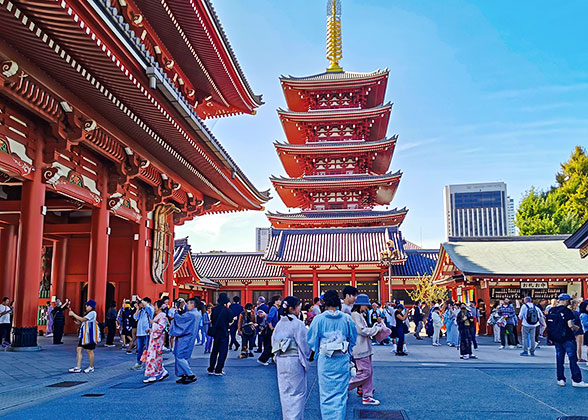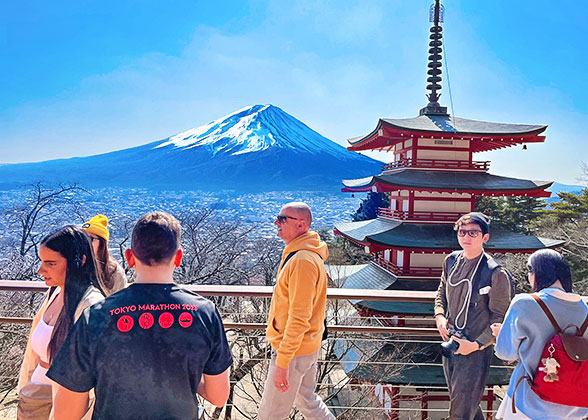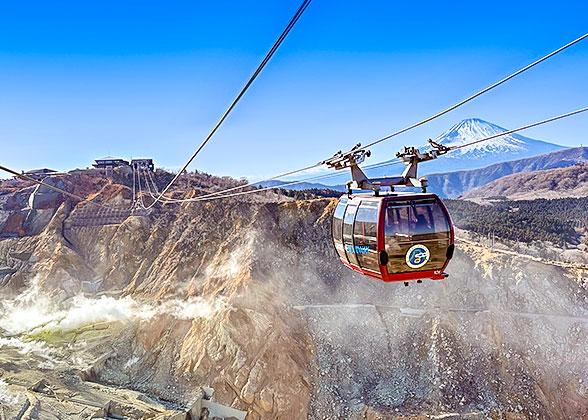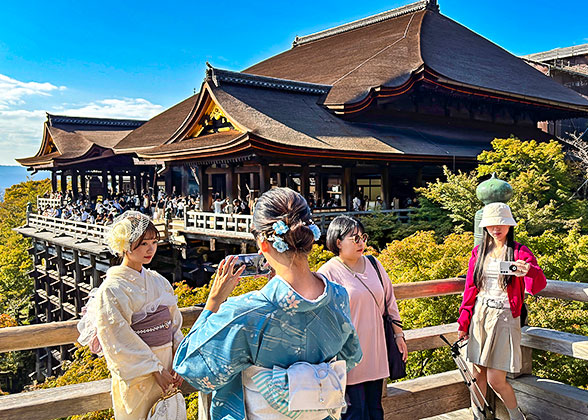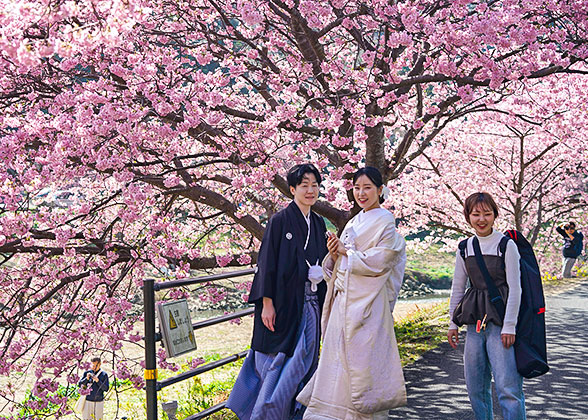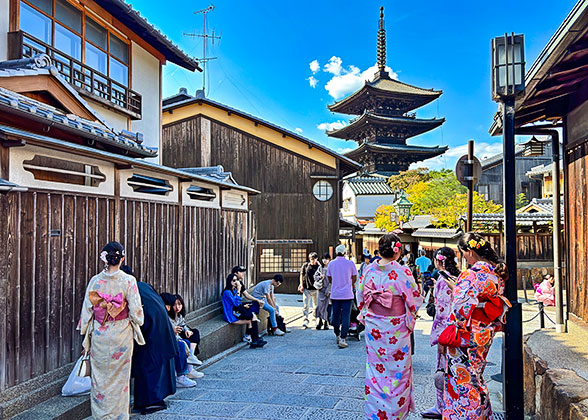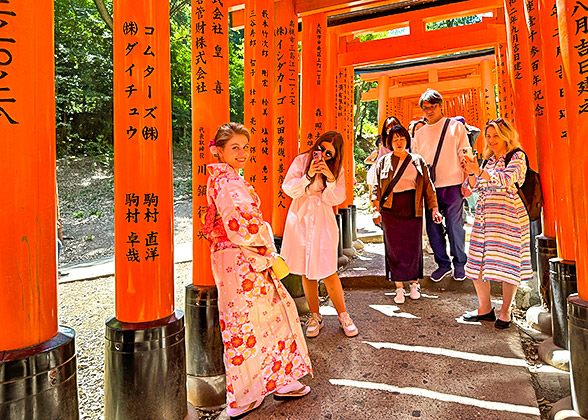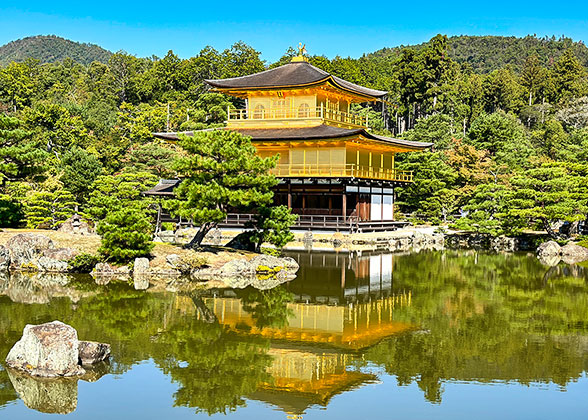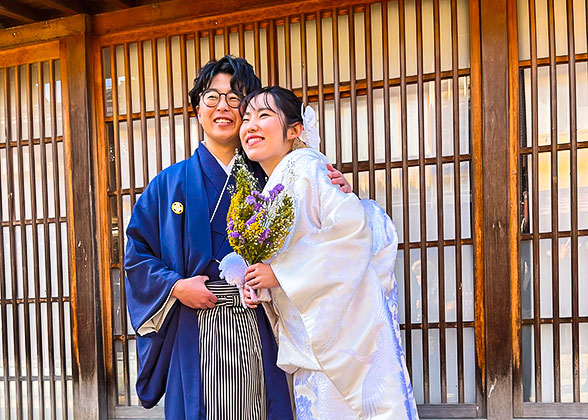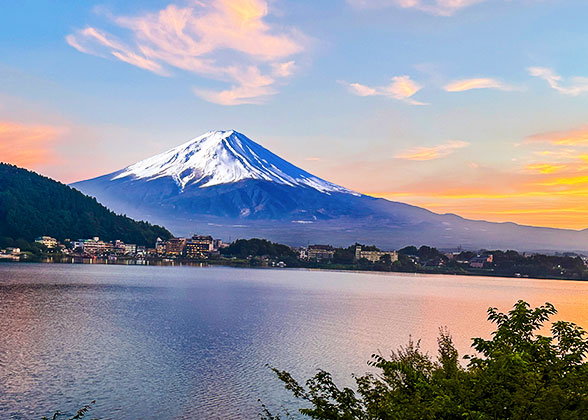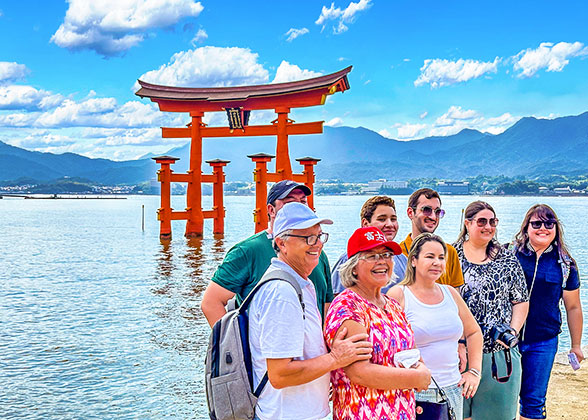Day 1: Tokyo Airport Pick-up by Private Car
Welcome to Japan! Upon your arrival at Tokyo’s airport, your luxury Japan tour package begins with a warm greeting from your private driver, followed by a comfortable, air-conditioned car transfer instead of squeezing into the busy and complicated subway system used by budget travelers. After a 1-hour drive from Narita Airport or a 30-minute drive from Haneda Airport, you’ll arrive at a luxury hotel offering excellent value and top-notch services in the prosperous Ginza or Shinjuku business districts - each selected by our local experts after multiple visits. The rest of the day is up to you. ► Explore Tokyo at Your Leisure Japan is recognized as one of the safest countries in the world, allowing you to stroll around without worrying about your safety until dark. Our hand-picked 4-star hotel in Shinjuku is just a 10-minute walk from the lively Kabukicho, home to many shops, restaurants, clubs, and the largest red-light district in Asia. After experiencing Tokyo’s authentic nightlife, consider finding an izakaya in the narrow alleys of Golden Street or Omoide Yokocho to sip a drink and sample local snacks, such as skewers and fried chicken. This is the perfect ending to your first night in Japan. If you choose the 5-star hotel in Ginza, known for its concentration of high-end shopping malls and international brands, you can seek out a Michelin restaurant where the authentic Kaiseki cuisine will exceed your expectations of exquisite Japanese food. Omoide Yokocho Authentic Japanese Food
See If This Trip Suits You Committed to creating a valuable itinerary for first-timers with limited time to explore Japan, our team believes that an expensive trip without genuine enjoyment would waste your money. Therefore, after careful travel planning, we’ll spend your funds wisely. In addition to private cars and upscale hotels, we have arranged special omakase sushi prepared by renowned chefs, a rickshaw ride, and geisha performances to ensure that every penny spent is worthwhile. We maintain the industry’s lowest gross profit of 6%, only 1/10 of other sellers’, allowing you to enjoy a luxurious experience at the most cost-effective price. Significantly, any content in our fully customizable itinerary, such as visits, transportation methods, and hotels, can be upgraded or downgraded according to your needs. Accommodation: Hotel Century Southern Tower (4 stars) or Hilton Tokyo (5 stars)
|
Day 2: Tokyo: Meiji Jingu Shrine, Shibuya, Senso-ji Temple, Roppongi Hills
Sanja Festival at Senso-ji Temple After enjoying a hearty breakfast, follow your guide on a private car ride to the Meiji Jingu Shrine, which honors the revered spirits of Emperor Meiji (1852 - 1912) and his wife, Empress Shoken. Nestled within a sacred forest of an astonishing 100,000 trees artificially planted over a century ago, the shrine offers a serene atmosphere amid the bustling city. As we walk through the exuberant pine, oak, and camphor trees toward the main hall, you’ll see two ‘couple camphor’ trees named after the emperor and empress, attracting a steady flow of worshippers who pray for a good marriage. Moreover, you may witness a captivating Shinto wedding ceremony showcasing graceful Japanese rituals. Then, leave the tranquility behind and plunge into the vibrant chaos of Shibuya Crossing, famed as the world’s busiest, with its spectacular pedestrian flow of up to 3,000 people crossing the road simultaneously. The guide will show you the Hachiko Memorial Statue nearby, which pays tribute to a loyal Akita dog whose touching story of waiting for his owner for a decade was adapted into several famous movies. With such deep love for dogs, it is easy to see why Japan has become the world’s most renowned dog-raising country, with one in six people owning a dog. ★ Premium Treat: Omakase Sushi LunchAround noon, we’ll take a lunch break at an Instagram-trending restaurant to savor omakase sushi (or teppanyaki), paired with a cup of sake. A local celebrity chef will transform fresh, high-quality seafood into exquisite sushi right before your eyes. The dazzling knife skills displayed in his magical hands serve not only to achieve the final presentation but also enhance the taste of the fish fillet. The chef must judge and decide within a few seconds which knife techniques to employ, ensuring they do not compromise the ingredients’ texture. What an eye-opening experience! After lunch, let’s proceed to the traditional entertainment district of Asakusa, where you’ll first pass through the towering, red Kaminarimon Gate that symbolizes the gateway to the spiritual realm, and enjoy a special treat of a 30-minute rickshaw ride. A rickshaw man clad in traditional attire will take you down several inviting backstreets surrounding the bustling Nakamise-dori Street, filled with Showa-era nostalgia, during which you can gravitate toward the majestic Tokyo Skytree in the distance. Then, we’ll reach the Senso-ji Temple. At the rear of the Hozomon Gate facing the main hall, you’ll be amazed by two enormous straw sandals, each 4.5 meters (14.7 feet) long and weighing 500 kilograms (1,102 pounds). Made for the Nioh who guard both sides, their impressive size reflects the vast body and boundless power of the Nioh guardians, deterring and exorcising evil spirits. When the straw sandals need to be changed every ten years, elementary school students weave the edge straps and tie blessing paper signs, symbolizing that ‘the new generation guards the tradition’. As the afternoon sun casts golden hues across the sky, we will head to the hidden gem, Roppongi Hills. While it may not be the tallest skyscraper, it is the perfect spot to capture both Tokyo Tower and Tokyo Skytree in a single shot. Plus, you won’t have to wait in long lines like at Tokyo Skytree. From the 52nd-floor observation deck, you can admire the stunning cityscape, including the Rainbow Bridge, Odaiba, and the shimmering expanse of Tokyo Bay. There’s also an open-air deck two floors higher. In addition to enjoying the sunset and nighttime views, you can explore the Mori Arts Center on the 53rd floor. Finally, your guide and the driver will escort you back to your hotel, Shinjuku Station, or Kabukicho if you like. Meals: Breakfast, Lunch Accommodation: Hotel Century Southern Tower (4 stars) or Hilton Tokyo (5 stars)
|
Day 3: Tokyo - Hakone - Mt. Fuji & Owakudani Valley - Lake Ashi Cruise - Odawara
This morning, your guide will pick you up at the hotel and accompany you on a 1.5-hour express train to Odawara, where we’ll board a one-hour Hakone Tozan Train that travels up the mountain, allowing us to enjoy the train’s zigzagging as it changes direction on steep slopes. Next, continue our journey on a retro Hakone Tozan Cable Car rumbling to Sounzan Station, and the subsequent Hakone Ropeway will take us to the first highlight of our Hakone tour: Owakudani Valley. While capturing a panoramic view of the magnificent volcanic valley, don’t miss out on another rare experience. ★ Exploration along the Owakudani Nature Study PathJoin the base security guard for a unique 40-minute adventure to explore the volcanic area more intimately. As you wander down the path, with volcanic scents in the air, you can observe the rising plumes and distinctive landscape up close. On a clear day, you may see the Hakone Mountains and Mount Fuji from the observation deck. At the hot spring ponds, you can watch staff making the famous Owakudani black eggs and have a taste; eating one is said to prolong your life by seven years. ► Note: Since the number of participants daily is quite limited, please inform us if you’re interested so we can make an appointment as early as possible. Due to the unique environment, the activity might be canceled if the air quality exceeds the volcanic gas standard or if adverse weather conditions such as rain, strong winds, or fog occur. Next, we’ll continue on the Hakone Ropeway for 30 minutes, during which you can enjoy sweeping vistas of Lake Ashi and Mt. Fuji, particularly the breathtaking views of Mt. Fuji’s elegant snow-capped summit. Due to the frequent cloudy and rainy weather, Mt. Fuji is often shrouded in a playful veil of clouds for nearly two-thirds of the year, while it is most visible during winter when there are more sunny days. May you be blessed with clear skies to appreciate the majestic mountain in all its glory. After arriving at Togendai Port, let’s embark on a roughly 30-minute Lake Ashi cruise aboard a unique ship with a striking exterior resembling an ancient pirate ship. Standing at the bow as you glide over the crystal-clear waters, you’ll admire the enchanting reflection of Mt. Fuji in the lake, complemented by the surrounding scenery. Zoom in and take captivating pictures as your gaze is drawn to a grand red torii that seems to float on the lake’s surface - the Peace Torii of Hakone Shrine. Finally, your guide will escort you to the hotel in Odawara in about one hour by local bus. ► For Your Information If your schedule permits, consider adding one day here to stay in an onsen ryokan in Hakone Yumoto and visit more of Hakone’s highlighted attractions the next day. Whether you want to relax at Gora Park, admire Lake Ashi and Mt. Fuji once more at the Onshi Hakone Park, or explore various art museums such as the Hakone Open-Air Museum, Venetian Glass Museum, and Narukawa Art Museum, we can customize a personalized itinerary for you. Meals: Breakfast Accommodation: Tenseien Odawara Station Annex (4 stars)
|
Day 4: Odawara to Kyoto; Visit East Temple, Pure Water Temple & Gion, Enjoy Geisha Show
Today, you’ll first take the train from Odawara to Kyoto by yourself. However, don’t worry; your hotel is just a one-minute walk from Odawara Station, and we will purchase you tickets with reserved seats in advance. After a 2- to 3-hour train ride to Kyoto, you’ll meet the local guide at the station and be greeted by the Kyoto Tower upon your exit. Check into the hotel, and the guide will take you to the East Temple, an important Buddhist site associated with the Japanese monk Kukai. As an envoy to the Tang Dynasty, he systematically studied esoteric Buddhist classics for two years (804-806) at Qinglong Temple in Chang’an (now Xi’an), China. After Kukai returned to Japan with numerous Buddhist scriptures, instruments, and texts, he established Japanese Shingon Buddhism at the East Temple, rapidly becoming one of the mainstream sects of Japanese Buddhism. Additionally, he significantly influenced the development of Japanese religion, literature, calligraphy, medicine, and tea culture. Pure Water Temple, Kyoto Cherry Blossom in Japan
Let’s continue to Pure Water Temple, where you’ll marvel at its Buddhist architecture and climb onto the massive wooden Kiyomizu Stage, a platform extending from the main hall and clinging to the cliffside, constructed without a single nail. An old Japanese saying goes, ‘jump off Kiyomizu Stage’, stemming from the belief that daring to jump from the stage would grant one’s wishes. Shockingly, hundreds of people did it! The government later enacted laws to forbid this suicidal act, and now the phrase metaphorically means ‘make up your mind to do something’. You can poke your head out from the handrail to appreciate its height and enjoy a panoramic view of Kyoto. If you want to capture distinctive Japanese-style photos with the ancient Pure Water Temple, consider renting a kimono to create unique memories in Kyoto. Out of the temple, our Gion walking tour begins. Let’s stroll along the lively ramped pedestrian streets of Sannenzaka and Ninenzaka, admiring the traditional Japanese architecture, teahouses, and souvenir stalls that flank the paths. Take photos in front of the five-story Yasaka Pagoda before we continue to Maruyama Park, renowned for its 200-year-old weeping cherry tree with stunning blossoms in spring. Visit the Yasaka Shrine, whose doorsteps finally lead us to Gion, Kyoto’s geisha district, where you might have a chance to see kimono-clad geishas walking past. ★ Enjoy a Geisha Show at Gion Corner TheaterA tour to Japan is not complete without watching a traditional geisha performance. Therefore, our luxury tour includes an enriching, up-close experience with premium VIP seats at a renowned local theater, rather than informal performances in small teahouses. Dressed in kimonos, adorned with delicate oshiroi makeup and exhibiting graceful manners, these geishas specialize in various artistic performances, offering a sumptuous feast of several authentic traditional Japanese arts all at once, including Kyoto-style dance, Japanese court dance, Koto instrument playing, flower arranging, tea ceremony, and puppet show. Yasaka Pagoda Geisha Show
Recommendation for Dinner (at your own expense) After the show, you can walk 10 minutes south from the theater to a Michelin one-star restaurant, Tempura Endo Yasaka (North). Its dishes primarily consist of various tempura made from seasonal vegetables, seafood, and freshwater fish, so it’s advisable to try extraordinary selections from the seasonal menu. After dinner, you can stroll through South Gionmachi to admire the night view before taking a 10-minute taxi back to the hotel. Average Cost per Person: USD 70 Address: 566, Komatsucho, Higashiyama Ward, Kyoto Meals: Breakfast Accommodation: Mitsui Garden Hotel Kyoto Station (4 stars) or The Thousand Kyoto (5 stars)
|
Day 5: Kyoto: Fushimi Inari Shrine, Golden Pavilion & Nijo Castle; Transfer to Osaka
Hozenji Temple, Osaka After breakfast, your guide and driver will take you to appreciate Kyoto’s exceptional World Heritage Sites. The first destination is the Fushimi Inari Shrine, which features the iconic Senbon Torii (Thousand Torii Gates), a long row of thousands of vermilion torii gates stretching up to the mountaintop. Why are there so many torii gates? This relates to the Mitsukoshi Department Store. Around 1727, its second-generation successor brought his family to worship at an Inari Shrine, and their small kimono shop gradually evolved into the largest department store group in Japan. Such success sparked a trend of constructing torii gates at Inari Shrines across Japan to pray for business prosperity and a successful life. As the headquarters of all Inari Shrines in Japan, Fushimi Inari Shrine thus boasts a breathtaking scene with thousands of torii gates. Next, proceed to the Golden Pavilion, which will impress you with its resplendent exterior and graceful reflection in the Mirror Pond. Since the Golden Pavilion has been rebuilt and restored twice, you might wonder how much gold foil was required to revitalize its glitter. Initially, only 2 kilograms of gold foil were used during the 1955 reconstruction, but it began to peel off after years of exposure to sunlight and rain due to its thinness; consequently, ten times that amount, or 200,000 sheets of gold foil, was used in the 1986 restoration! Afterward, continue following your guide to visit Nijo Castle, the residence of Tokugawa Ieyasu, who initiated the Edo Period (1603-1868). Cross the moat, pass through the city wall, and enjoy the gardens and architecture dating back to the early 17th century. From the well-preserved palaces, you can sense the supreme power of the Tokugawa shogunate in Japan. Late in the afternoon, your guide will escort you to Osaka in about 1.5 hours by private car. After a short break at the hotel, let’s explore Osaka’s most popular business and food districts: Hozenji Yokocho, Shinsaibashi, and Dotonbori. As we stroll through the bustling crowds beneath the dazzling, flashing neon shop signs on both sides of the canal, with the enticing smell of street snacks like takoyaki and sushi filling the air, you’ll unknowingly indulge in an endless carnival at Dotonbori’s night. In the end, your guide will escort you back to the hotel, or you can keep enjoying the nightlife here and return to the hotel on your own, just a less than 10-minute walk away. ► Where to Feast Yourself a Satisfying Dinner (at your own expense) If you prefer fine dining, which may cost USD 100-200 per person, the Michelin three-star restaurant Taian near Shinsaibashi specializes in charcoal grilling, and Guenpin Houzenji Souhonten in Hozenji Yokocho offers safe and rich puffer fish sashimi. For more affordable bites, you can try Kani Doraku Dotonbori Main Branch, marked by a giant crab sign, which offers various crab dishes, Yakiniku Rikimaru Nanba Dotonbori, a cost-effective barbecue buffet, Kobe Beef Steak Ken (Teppanyaki), or Kushikatsu Daruma famed for Kansai-style fried skewers, all of which will entertain you while costing only USD 30-60 per person. Meals: Breakfast Accommodation: Namba Oriental Hotel (4 stars) or Swissotel Nankai Osaka (5 stars)
|
Day 6: Osaka Airport See-off
On the last day of your luxury Japan tour, you’ll be accompanied on a private car ride to Osaka Kansai International Airport based on your flight schedule. We hope you’ve enjoyed the journey and a nice trip home! If you wish to continue visiting Nara, Hiroshima, or Nagoya, or travel to neighboring countries such as China, South Korea, and Mongolia, please contact us anytime to customize an extended itinerary!
► Suggested Osaka Extension for Your Free Time:
If your departure flight is late afternoon or evening, consider exploring Osaka’s famous attractions on your own or contacting us to add a guided tour service. The Kuromon Market near your hotel offers a glimpse into the vitality of the Japanese morning market, where fresh sea catches are soon made into delicacies, providing a unique tasting experience. Osaka Castle Park is also worth visiting, with the striking black and white Osaka Castle at its center, surrounded by the inner moat and lush gardens. Additionally, you can ask for a stop at Sumiyoshi Grand Shrine on the way to the airport, appreciating a distinctive style of shrine architecture and its symbolic red-hued bridge.
Meals: Breakfast
|




